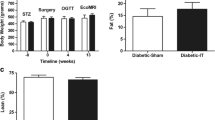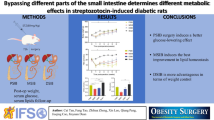Abstract
Background
The surgical treatment for obesity promotes massive weight loss and early improvement in co-morbid conditions such as type-2 diabetes. Because surgically mediated glycemic improvements are immediate, the mechanisms involved appear to be weight loss independent. Ileal interposition has been used to gain understanding of the relative role that the lower intestine plays in mediating metabolic improvement. Here, we report that ileal interposition is sufficient for improving glucose tolerance in a low-dose streptozotocin-treated diabetic rat model as well as in normal rats with no effect on body weight.
Methods
Male Long–Evans rats were treated with streptozotocin (35 mg/kg) or left untreated and then received sham or ileal interposition. Body weight was measured as well as glucose and insulin tolerance. Plasma insulin and gut hormones were measured during the glucose tolerance test.
Results
Streptozotocin treatment resulted in hyperglycemia within 48 h after treatment. Diabetic rats with ileal interposition showed improvement in glucose tolerance as early as 4 weeks after surgery compared to sham (p < 0.05). By 11 weeks after surgery glucose and insulin tolerance was markedly improved in interposed-diabetic compared to sham-diabetic rats (p < 0.05). Normal non-diabetic rats showed improved glucose tolerance after ileal interposition compared to sham (p < 0.05). Insulin secretion was increased in interposed rats following glucose administration (p < 0.05). The ileal-derived hormones glucagon like peptide-1 (GLP-1), peptide YY (PYY), and glucagon were all significantly elevated in the ileal interposed rats (p < 0.01). Gastric inhibitory polypeptide (GIP) was unchanged. In neither study did body weight between the surgical groups differ at any time point.
Conclusions
Ileal interposition effectively improves glucose tolerance in streptozotocin-diabetic and euglycemic rats. Enhanced insulin secretion can explain the lowered glucose concentrations in euglycemic rats following ileal interposition. Ileal interposition is associated with dramatically elevated ileal hormones, GLP-1, PYY, and glucagon (p < 0.01) with no change in the duodenal hormone GIP.








Similar content being viewed by others
References
Buchwald H, Avidor Y, Braunwald E, et al. Bariatric surgery: a systematic review and meta-analysis. Jama 2004;292:1724–37.
Atkinson RL, Whipple JH, Atkinson SH, et al. Role of the small bowel in regulating food intake in rats. Am J Physiol 1982;242:429–33.
Mason EE. Ileal [correction of ilial] transposition and enteroglucagon/GLP-1 in obesity (and diabetic?) surgery. Obes Surg 1999;9:223–8.
Depaula AL, Macedo AL, Rassi N, et al. Laparoscopic treatment of metabolic syndrome in patients with type 2 diabetes mellitus. Surg Endosc 2008;22:706–16.
Patriti A, Facchiano E, Annetti C, et al. Early improvement of glucose tolerance after ileal transposition in a non-obese type 2 diabetes rat model. Obes Surg 2005;15:1258–64.
Strader AD, Vahl TP, Jandacek RJ, et al. Weight loss through ileal transposition is accompanied by increased ileal hormone secretion and synthesis in rats. Am J Physiol Endocrinol Metab 2005;288:E447–53.
Perfetti R, Zhou J, Doyle ME, et al. Glucagon-like peptide-1 induces cell proliferation and pancreatic-duodenum homeobox-1 expression and increases endocrine cell mass in the pancreas of old, glucose-intolerant rats. Endocrinology 2000;141:4600–5.
Xu G, Stoffers DA, Habener JF, et al. Exendin-4 stimulates both beta-cell replication and neogenesis, resulting in increased beta-cell mass and improved glucose tolerance in diabetic rats. Diabetes 1999;48:2270–6.
Li Y, Hansotia T, Yusta B, et al. Glucagon-like peptide-1 receptor signaling modulates beta cell apoptosis. J Biol Chem 2003;278:471–8.
Junod A, Lambert AE, Stauffacher W, et al. Diabetogenic action of streptozotocin: relationship of dose to metabolic response. J Clin Invest 1969;48:2129–39.
Koopmans HS, Ferri GL, Sarson DL, et al. The effects of ileal transposition and jejunoileal bypass on food intake and GI hormone levels in rats. Physiol Behav 1984;33:601–9.
Wang TT, Hu SY, Gao HD, et al. Ileal transposition controls diabetes as well as modified duodenal jejunal bypass with better lipid lowering in a nonobese rat model of type II diabetes by increasing GLP-1. Ann Surg 2008;247:968–75.
Goto Y, Kakizaki M, Masaki N. Production of spontaneous diabetic rats by repetition of selective breeding. Tohoku J Exp Med 1976;119:85–90.
Wickremesekera K, Miller G, Naotunne TD, et al. Loss of insulin resistance after Roux-en-Y gastric bypass surgery: a time course study. Obes Surg 2005;15:474–81.
Pories WJ, Swanson MS, MacDonald KG, et al. Who would have thought it? An operation proves to be the most effective therapy for adult-onset diabetes mellitus. Ann Surg 1995;222:339–50. discussion 350-2.
Morsiani E, Carpanelli MC. Observations on the metabolic effects of partial jejunoileal bypass in streptozotocin-treated rats. Eur Surg Res 1985;17:25–32.
Barry RE, Barisch J, Bray GA, et al. Intestinal adaptation after jejunoileal bypass in man. Am J Clin Nutr 1977;30:32–42.
Morinigo R, Moize V, Musri M, et al. Glucagon-like peptide-1, peptide YY, hunger, and satiety after gastric bypass surgery in morbidly obese subjects. J Clin Endocrinol Metab 2006;91:1735–40.
Valverde I, Puente J, Martin-Duce A, et al. Changes in glucagon-like peptide-1 (GLP-1) secretion after biliopancreatic diversion or vertical banded gastroplasty in obese subjects. Obes Surg 2005;15:387–97.
Tourrel C, Bailbe D, Meile MJ, et al. Glucagon-like peptide-1 and exendin-4 stimulate beta-cell neogenesis in streptozotocin-treated newborn rats resulting in persistently improved glucose homeostasis at adult age. Diabetes 2001;50:1562–70.
Malendowicz LK, Macchi C, Nussdorfer GG, et al. Effects of prolonged exendin-4 administration on entero-insular axis of normal and streptozotocin-induced diabetic rats. Int J Mol Med 2003;11:763–6.
Tsuchiya T, Kalogeris TJ, Tso P. Ileal transposition into the upper jejunum affects lipid and bile salt absorption in rats. Am J Physiol 1996;271:G681–91.
Ermini M, Iaconis E, Mori A. The effects of bilio-jejunal diversion on streptozotocin diabetes in the rat. Acta Diabetol Lat 1991;28:79–89.
Manfredini G, Ermini M, Scopsi L, et al. Internal biliary diversion improves glucose tolerance in the rat. Am J Physiol 1985;249:G519–27.
Patti ME, Bernier R, Bianco AC, et al. Gastric bypass surgery increases plasma bile acid levels: potential contribution to improved glucose tolerance. Chicago, Illinois, American Diabetes Association Annual Meeting; 2007.
DePaula AL, Macedo AL, Rassi N, et al. Laparoscopic treatment of type 2 diabetes mellitus for patients with a body mass index less than 35. Surg Endosc 2008;22:706–16.
Service GJ, Thompson GB, Service FJ, et al. Hyperinsulinemic hypoglycemia with nesidioblastosis after gastric-bypass surgery. N Engl J Med 2005;353:249–54.
Deitel M. Surgery for diabetes at lower BMI: some caution. Obes Surg 2008;18:1211–4.
Acknowledgement
The present studies were funded in part through a research grant to A.D.S. from the American Society for Metabolic and Bariatric Surgery. We also thank Gitte Koelander Hansen and Vibeke Nielsen for technical assistance, Johannes Josef Fels and Hanne Skov Pedersen for carrying out glucagon analysis and Christian Rosenquist and Susanne Halkier for carrying out total GLP-1 analysis.
Author information
Authors and Affiliations
Corresponding author
Rights and permissions
About this article
Cite this article
Strader, A.D., Clausen, T.R., Goodin, S.Z. et al. Ileal Interposition Improves Glucose Tolerance in Low Dose Streptozotocin-treated Diabetic and Euglycemic Rats. OBES SURG 19, 96–104 (2009). https://doi.org/10.1007/s11695-008-9754-x
Received:
Accepted:
Published:
Issue Date:
DOI: https://doi.org/10.1007/s11695-008-9754-x




